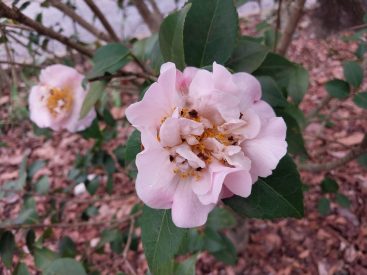Learn—month by month—the necessary gardening activities for lawns and shrubs, annuals and perennials, fruit and nut trees, and bulbs, roots, and tubers. Included is a timeline for activities such as soil testing, planting, pruning, fertilizing, pruning, mulching, indoor plantings—from cauliflower to okra, from camellias to dahlias to heirloom roses.

Photo courtesy of Dawn Whitehead
FEBRUARY
Fruits and Nuts
Planting season continues for dormant trees.
Fertilize fruit trees.
Apply half of the fertilizer recommended for grapes now; apply the other half soon after fruit sets.
Continue dormant pruning and grafting. Start strawberry plantings.
Shrubs
Planting season continues.
Visit camellia shows to learn of hardy varieties in your area.
Graft camellias in central and south Alabama.
Spray all shrubs with a fungicide before new growth starts.
Prune all shrubs before new growth starts.
Don’t prune early-blooming species because flower buds will be removed.
Roses
Prune hybrid tea roses in south Alabama; delay pruning for a few weeks in north Alabama.
Continue planting.
Annuals and Perennials
Replant early plantings of hardy annuals.
Prepare beds for summer annuals.
Bulbs
Plant cannas, amaryllis, gladiolus, and zephyranthes in south Alabama; delay planting for a few weeks in north Alabama.
Miscellaneous
House plants are beginning to show signs of activity.
Fertilize with liquid or soluble fertilizer according to manufacturer’s directions.
Remember Valentine’s Day. Why not send roses or a potted plant?
Lawns
Apply preemergent herbicides if forgotten in September and if spring weeds were a concern last year.
If south Alabama’s winter was mild, centipede grass may not be fully dormant. Monitor for fungal disease.
Vegetable Seeds
South and Central: Plant the same vegetables listed for January. Add carrots, Swiss chard, kohlrabi, lettuce, spinach, radishes, turnips, and additional plantings of leafy greens.
North: Plant kale. Wait until the end of February to plant beets, carrots, collards, garden peas, kale, kohlrabi, mustard, spinach, Swiss chard, radishes, and turnips.
Vegetable Transplants
Whole state: Plant asparagus, cabbage, broccoli, onion sets, kale, lettuce, cauliflower, and Brussels sprouts.
South and Central: Plant asparagus, cabbage and broccoli, and certified seed potatoes for Irish and red- skinned varieties.
North: Wait towards the end of the month to plant certified seed potatoes for Irish and red-skinned varieties and asparagus.
MARCH
Fruits and Nuts
Continue strawberry and grape plantings.
Bud apples and peaches.
Start planting blackberries. If weather conditions prevent prompt planting, heel the plants in by placing the root system in a trench and covering the soil.
Shrubs
Fertilize shrubs (except azaleas and camellias) according to a soil test.
Late plantings may be made, particularly if they are container grown.
Monitor shrubs for harmful insects.
Lawns
Plant bermudagrass, zoysiagrass, and centipedegrass in south Alabama.
Soil test and add limestone as recommended.
Fertilize fescue lawns at 1 pound slow-release nitrogen per 1,000 square feet.
South: If daytime temps are consistently above 70 degress F, consider applying fire ant bait. Read label carefully for best control.
Roses
Watch new growth for aphids.
Begin a spray or dust program.
Begin fertilizing.
Annuals and Perennials
South: Plant half-hardy annuals.
Check garden centers for bedding plants such as geraniums and petunias.
Bulbs
Plant gladiolus every 2 or 3 weeks if a long blooming season is desired.
Plant tuberous begonias in pots. Plant dahlias.
Miscellaneous
Check and repair sprayers, dusters, and lawn mowers.
Control lawn weeds with chemicals as needed. If weeds are deemed a serious problem, send a soil sample for testing as weeds can indicate the lawn is unhealthy.
Delay pruning of fruiting shrubs such as cotoneasters, pyracanthas, and hollies until after flowering.
Vegetable Seeds
Central and North: Plant all hardy crops recommended for January and February (garden peas, leafy greens, and root crops).
Central and South: Continue planting carrots, lettuce, and radishes. Plant sweet corn and squash. South Alabama can start planting beans, melons, and southern peas in late March.
Vegetable Transplants
Central and North: Plant asparagus, onion sets, and lettuce. Plant certified seed potatoes for Irish and red- skinned varieties in early March.
South: Harden off tomato, pepper, and eggplant transplants. Plant when the soil has warmed above 65 degrees F and the threat of frost is over.

 Menu
Menu Search
Search



